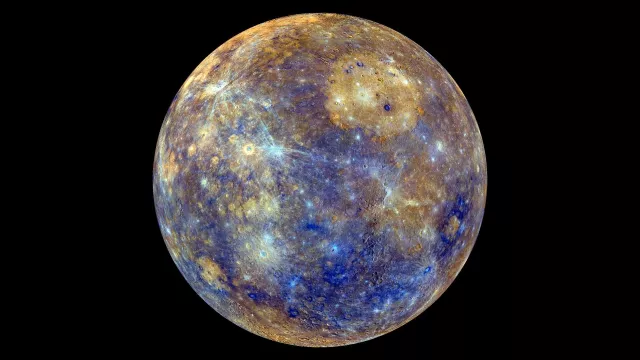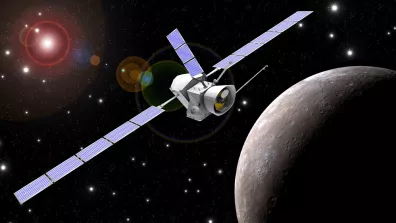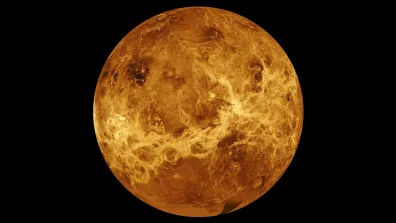Mercury is the smallest planet in the solar system and the closest to the Sun, which it circles at great speed. This proximity means temperatures on the surface are extremely hot and makes it hard to explore.
Fast figures
| Distance from Sun | 46 to 70 million km (0.31 to 0.47 AU) |
| Volume | 6.083 x 1010 km3 (0.056 that of Earth’s) |
| Mass | 3.3 x 1023 kg (18 times less than Earth’s) |
| Diameter | 4,879 km (about three times smaller than Earth) |
| Gravity | 38% that of Earth’s |
| Axial tilt | 0.01° |
| Revolution period | 88 Earth days |
| Rotation period | 58.6 Earth days |
| Temperature | –180 °C to +430 °C (+67 °C on average at equator) |
| Known moons | 0 |
A scarred telluric planet
Mercury is a telluric planet, that is, a rocky planet like its neighbours Venus, Mars and Earth. But it has an oversize iron-rich core that sets it apart.
- Big core under a rocky crust
Mercury’s thin rocky crust—only ten kilometres thick—overlies a mantle of semi-molten rock composed mainly of iron, sulphur and silicate, approximately 600 kilometres thick. The metallic core, likely liquid, takes up nearly two-thirds of its volume (61% versus 17% for Earth’s core). This makes Mercury a particularly dense planet.
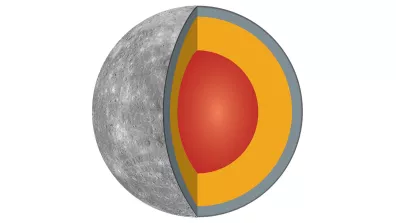
- Craters, craters everywhere
The surface of Mercury is a heavily cratered desert that looks much like the Moon’s. These scars are the traces of the many meteorite impacts during its formation. The planet’s surface is also covered by numerous plains, the remnants of ancient lava flows from volcano eruptions or meteorite impacts. Today, Mercury is considered a dead planet, with no internal activity.
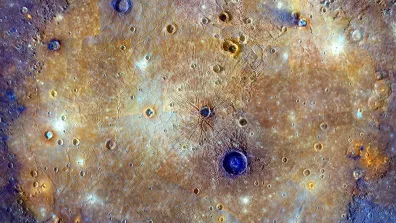
- Sunbathers beware
Rather than an atmosphere, Mercury has an exosphere of trace gases and particles from the solar wind. As a result, it has no protection from the Sun’s rays and cannot retain heat when it goes into shadow. The planet thus experiences record temperature swings, scorching hot during daytime (up to +430°C) and freezing cold at night (down to –180°C).
Mercury’s dance
Mercury’s physical characteristics, combined with its small size and proximity to the Sun, whose attraction exerts a strong influence, all make for a rather special orbital choreography.
- Zipping around the Sun
The Sun’s proximity means that it exerts a very strong force of attraction on the tiny planet. As a result, Mercury zips around the Sun at a speed of 170,000 km/h, taking only 88 days to complete its orbit. On the other hand, it spins very slowly on its axis, taking the equivalent of 59 Earth days to complete one rotation (a sidereal rotation or sidereal day). This means a solar day on Mercury—the time taken for the Sun to return to the same point on the meridian—lasts two-thirds of a Mercury year.
- A yo-yo orbit
Mercury’s relationship with the Sun is a very tumultuous one. Besides speeding frenetically around its star, it also has the most eccentric orbit in the solar system. In other words, this orbit is elliptical (oval-shaped), so its distance from the Sun varies considerably—from about 46 million kilometres at its closest point to about 70 million kilometres at its furthest.
Video of Mercury moving across the Sun captured at different wavelengths by the Solar Dynamics Observatory satellite in 2019. © NASA's Goddard Space Flight Center
Hard to get close
Mercury can’t be observed with a telescope from Earth because it’s almost always lost in the Sun’s glare. It’s also difficult to send a spacecraft so close to the Sun, whose gravitational attraction and radiation can prove fatal. As a result, Mercury remains something of a mystery.
- The Sun: Mercury’s guardian
After two flybys of the U.S. Mariner 10 probe in 1973 and 1974, Mercury was no longer visited until… 2011. The U.S. MESSENGER (MErcury Surface, Space ENvironment, GEochemistry and Ranging) probe went into orbit around the small planet, where it was able to conduct observations for four years. Despite its relative proximity to Earth (77 million kilometres at its closest, eight times closer than Jupiter, first visited by an orbital probe in 1995), the journey to Mercury is long and fraught with danger. It requires the spacecraft to be placed into orbit without being sucked in by the Sun’s gravitational pull, and its instruments must withstand our star’s extreme heat.
- BepiColombo
The second orbital mission to Mercury was launched in 2018. Named BepiColombo, it’s carrying two probes, one from Europe and one from Japan. The first, MPO (Mercury Planetary Orbiter), will map Mercury and study its internal structure and surface composition; the second, Mio, will analyse the planet’s magnetic field and magnetosphere. CNES oversaw the contribution of six French research laboratories to the probe’s 16 European instruments.
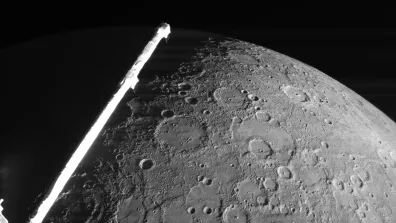
Quiz
What’s the maximum number of sunrises and sunsets you could see per day on Mercury?


